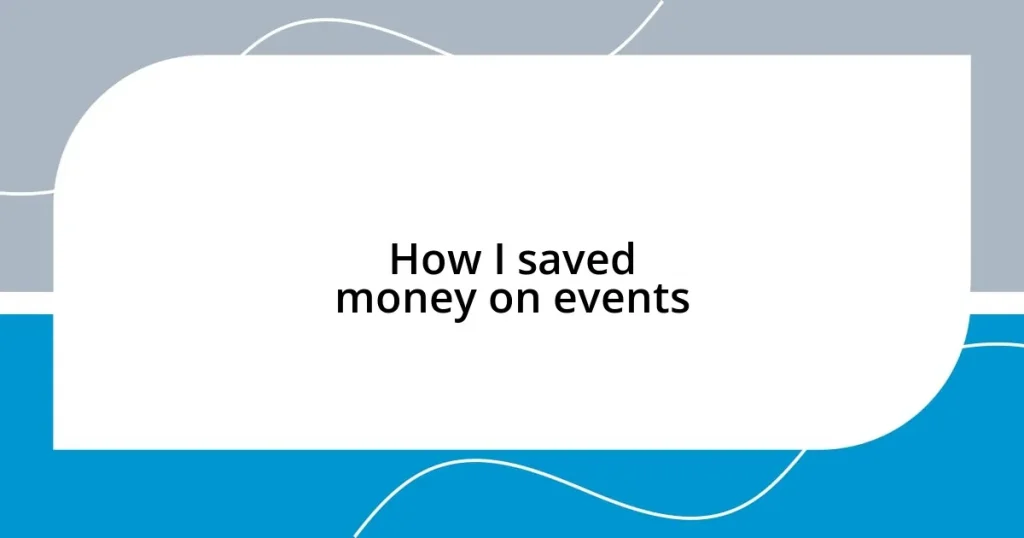Key takeaways:
- Costs can accumulate from various sources like catering, decorations, and vendor fees; it’s essential to prioritize budget allocations.
- Setting a realistic budget involves determining total costs, breaking it down by category, and allowing for unexpected expenses.
- Researching affordable venues and leveraging local sponsorships can significantly reduce event costs while maintaining quality experiences.
- Tracking and evaluating expenses helps identify areas for future savings and highlights the value received from each expenditure.
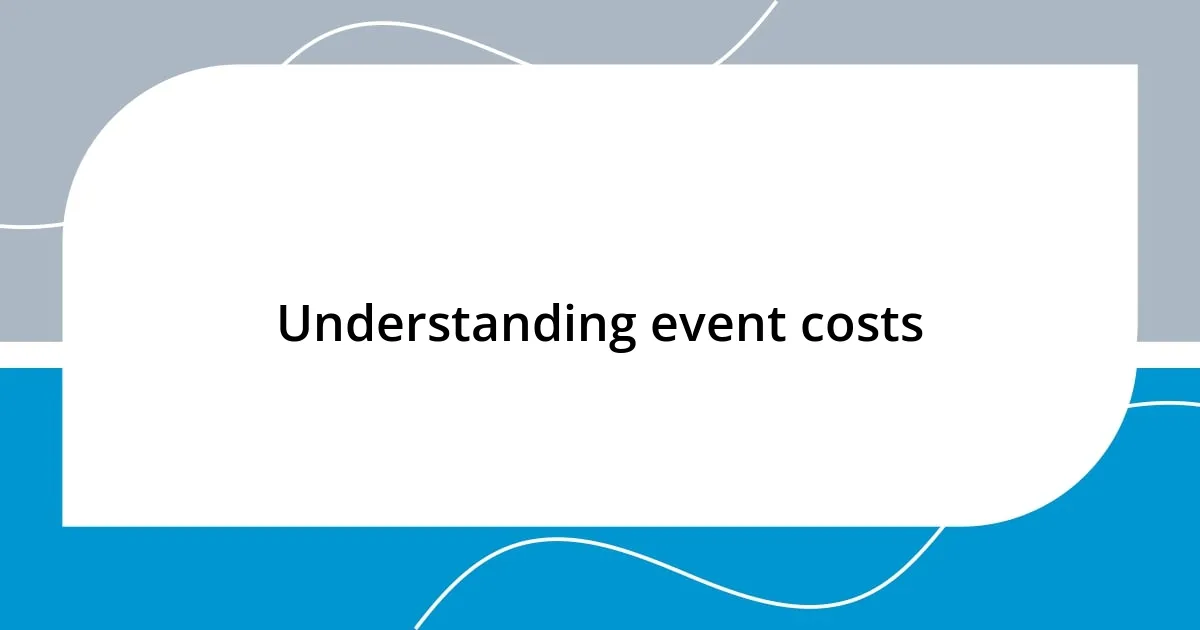
Understanding event costs
Understanding event costs goes beyond just the price tag on the venue. I once organized a small birthday party for my friend, and I was shocked to find that the catering was nearly half the budget! Have you ever found yourself faced with unexpected expenses that made you rethink your entire event? It’s crucial to recognize that costs can creep in from various angles: vendor fees, decoration, and even those fancy invitations can add up quickly.
In my experience, I learned that having a clear budget helped me prioritize essential elements. For instance, what really matters in an event? Is it the dazzling decor or the unforgettable experience shared with loved ones? During that birthday party, I chose to forgo elaborate centerpieces, which freed up funds for a live band. This trade-off enhanced the atmosphere and made it an event to remember!
Moreover, understanding the timeline of payments is vital. I remember an event I attended where the organizer forgot about the deposit deadlines, leading to last-minute scrambling. Can you imagine the stress of chasing down cash at the eleventh hour? Having a detailed budget plan, outlining when each payment is due, can save you from the chaos and ensure your focus remains on creating a memorable occasion.
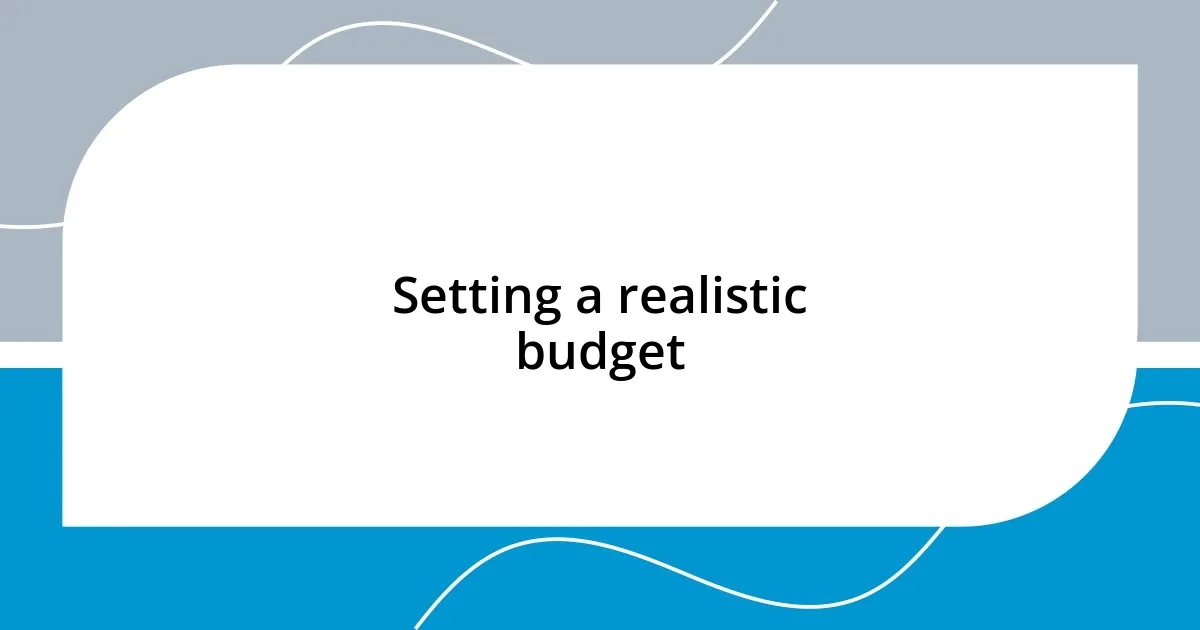
Setting a realistic budget
When it comes to setting a realistic budget, I’ve learned that the key is to assess what you can genuinely afford without stretching yourself too thin. I once jumped into budgeting for a wedding too quickly, driven by excitement. Instead of considering my overall financial situation, I focused on wish-list items, and, surprise—it sent me spiraling into stress! To avoid that panic, it’s essential to take a step back and think about your financial limits.
Here’s a practical list to help set a realistic budget:
- Determine your total budget: Identify the maximum amount you can comfortably spend.
- Break it down: Allocate portions of your budget to different categories, like venue, catering, and entertainment.
- Include a cushion: Set aside at least 10-15% of your budget for unexpected expenses.
- Track all expenses: Keep a detailed record of what you spend to stay on top of your budget.
- Be flexible: Be ready to adjust your budget as needed, especially if something unexpectedly pops up.
I remember a particularly enlightening moment when I adjusted my budget for a friend’s wedding. With some honest conversations and careful planning, we managed to trim down certain less-critical elements to prioritize an exquisite dinner for our guests. The joy of watching everyone indulge in great food underscored the importance of revisiting those budget allocations!
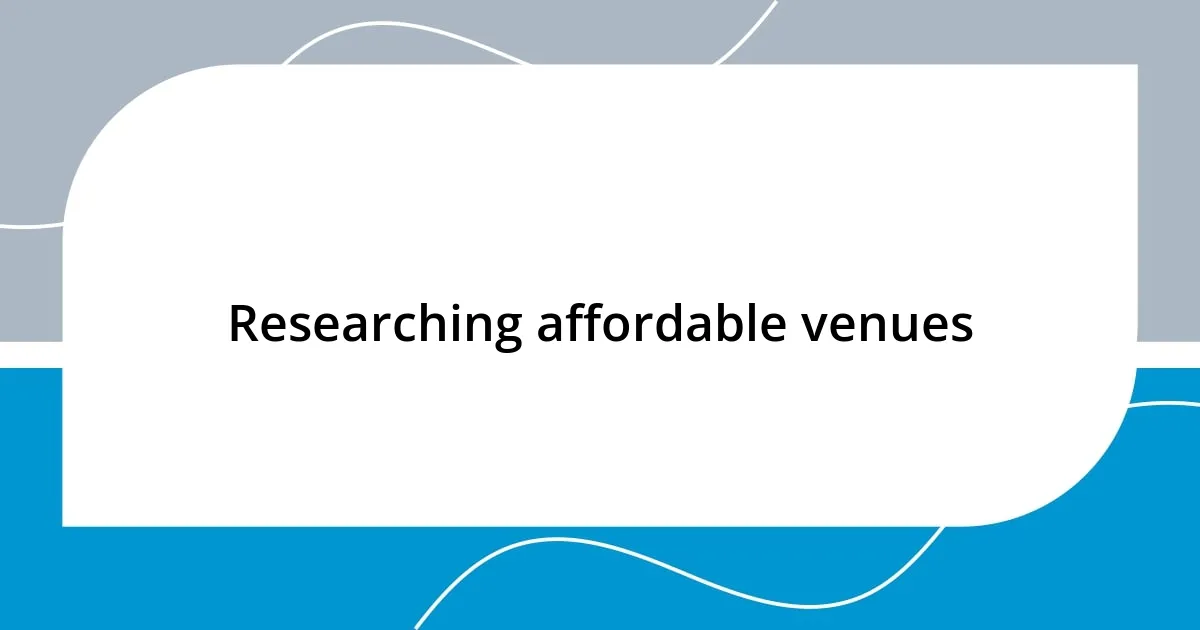
Researching affordable venues
When it comes to researching affordable venues, the process can feel daunting, but it doesn’t have to be. I remember when I was planning a community event and felt overwhelmed by the sheer number of options. To simplify, I started by listing venues that fit my budget and capacity requirements. This helped me eliminate choices that were out of reach and focus on what was truly available to me. Have you ever felt stuck in decision-making because of too many possibilities? Narrowing it down can create clarity.
I often found that local parks or community centers offered hidden gems. For instance, I booked a small community hall for a family reunion, which was not only economical but also provided ample space for games and activities. Plus, the added bonus of a kitchen made catering logistics much simpler and more affordable. I realized that sometimes, the most memorable venues aren’t the swanky, expensive spots; they’re the ones where you can inject creativity and make lasting memories.
To ensure I was making a smart choice, I created a comparison table based on various factors like cost, capacity, and amenities. This visual guide helped me weigh my options effectively and led me to the perfect venue—all while keeping my budget intact!
| Venue | Cost |
|---|---|
| Local Park | $150 |
| Community Center | $300 |
| Private Event Hall | $800 |
| Backyard | Free |
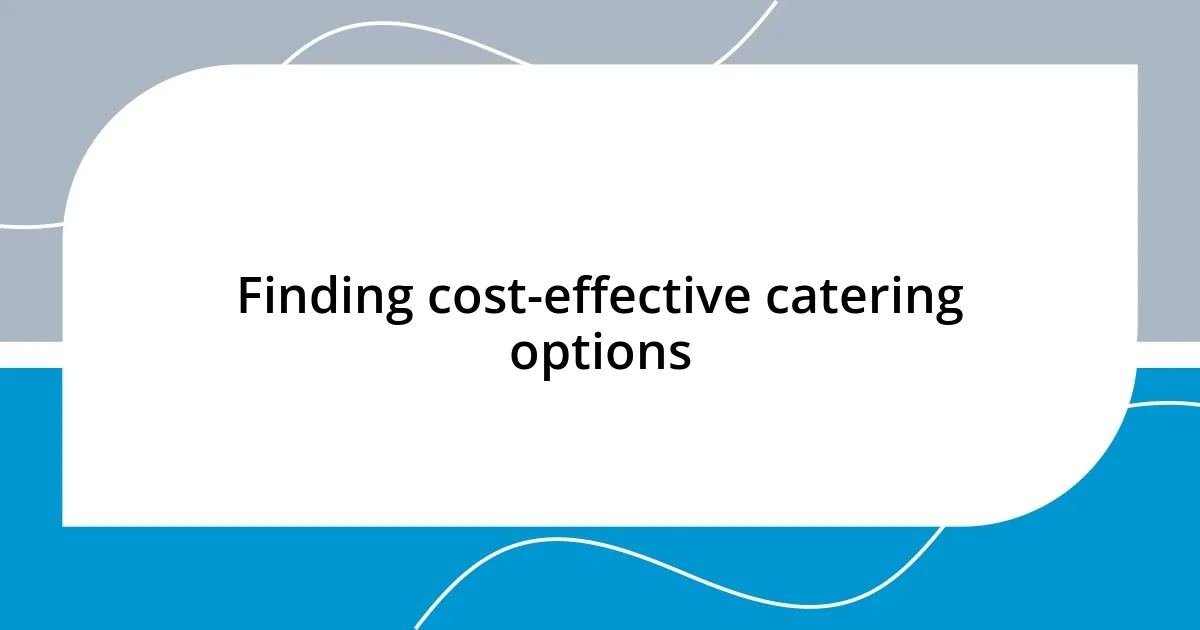
Finding cost-effective catering options
Finding cost-effective catering options can feel like a maze, especially when you want to provide a memorable dining experience without breaking the bank. I remember a memorable birthday party where I discovered the beauty of local food trucks. Instead of a traditional caterer, I hired a taco truck. The result? Delicious food that my guests adored, and it actually cut costs by nearly 30% compared to conventional catering. Who knew that delighting your guests could come from a casual dining experience?
Moreover, buffet-style catering can significantly reduce expenses while offering variety. During my sister’s graduation party, we opted for a buffet that allowed guests to customize their plates. This not only catered to diverse tastes but also minimized waste, as everyone picked what they enjoyed most. Isn’t it refreshing to know that providing choice doesn’t necessarily mean higher costs? It’s a win-win situation that keeps everyone happy.
Another effective strategy is to leverage off-peak times for your events. I once hosted a wedding brunch instead of a dinner, and it turned out to be not only delightful but much more budget-friendly. Offering a delicious brunch menu combined with mimosas turned out to be a fun twist that guests loved, while my wallet thanked me for avoiding premium dinner pricing. Have you considered unconventional timings for your events to save money while still ensuring a fabulous feast?
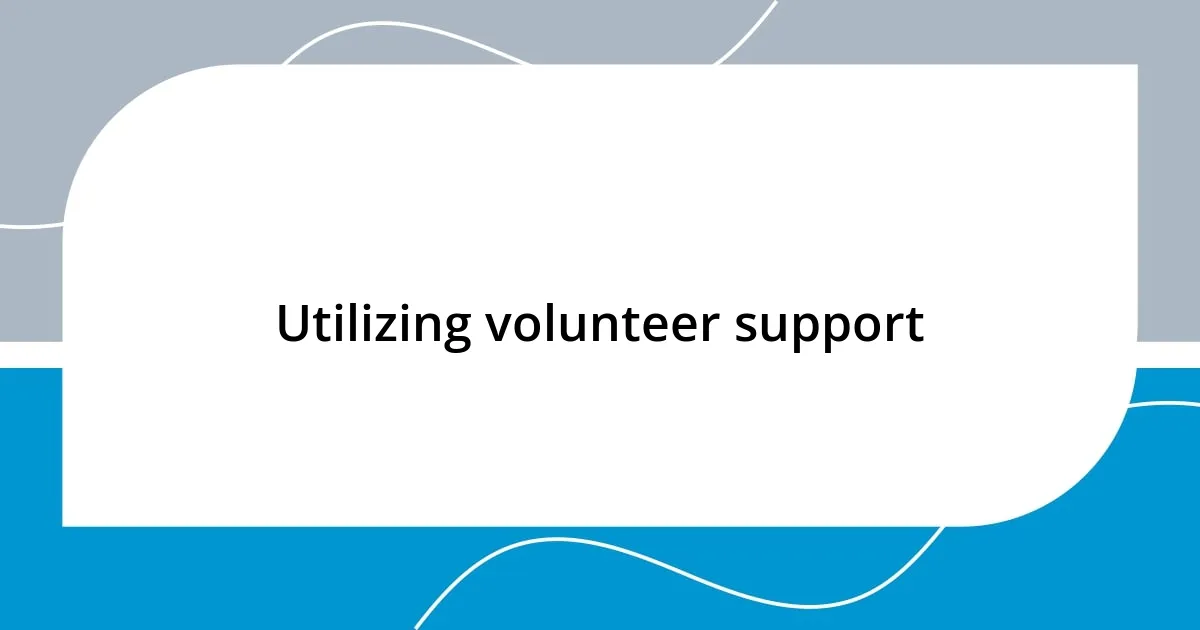
Utilizing volunteer support
Utilizing volunteers for events can be a game-changer in terms of cost savings. I once organized a neighborhood fair where I reached out to local high school students looking for community service hours. It amazed me how enthusiastic they were about helping out. Their energy made the event vibrant, and I didn’t have to worry about hiring extra staff, saving me a significant amount of money.
I found that volunteers often bring a sense of ownership and pride to an event. During a charity gala, we had a team of passionate individuals who were not only eager to assist but also had wonderful ideas for engagement activities. Their involvement not only saved on labor costs but also resulted in a more dynamic atmosphere. Have you considered how the dedication of volunteers can elevate your event beyond its monetary value?
Creating a clear structure for volunteer roles can enhance their experience while ensuring everything runs smoothly. I remember preparing detailed job descriptions for a community cleanup event. By providing guidance and allowing them to choose tasks that interested them, I not only made the work enjoyable but also fostered a sense of teamwork. The satisfaction of seeing the park transformed made it worth every moment we spent together, reinforcing the idea that community support can lead to incredible results without a considerable financial outlay.
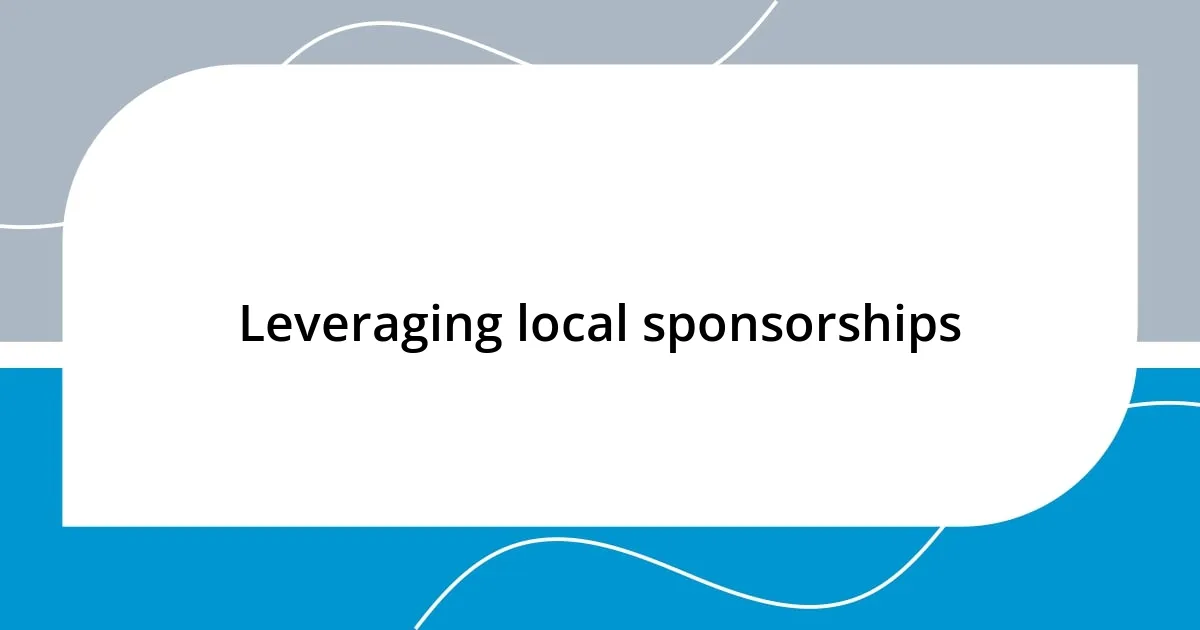
Leveraging local sponsorships
Leveraging local sponsorships has been one of my favorite ways to cut costs while planning events. I once hosted a community art festival and reached out to local businesses for sponsorships. To my surprise, several were eager to contribute not just funds, but also in-kind donations, like food and drinks. It felt great to see our community rally around a shared purpose, and the relief on my budget was definitely palpable. Isn’t it amazing how local businesses want to invest in their community?
During a recent charity run, I approached a local coffee shop and offered them a booth at the event in exchange for their sponsorship. Not only did they happily provide refreshments, but their involvement drew more participants to the race. The atmosphere buzzed with energy and camaraderie, creating a memorable experience for all involved. Have you thought about tapping into local businesses for your events? The benefits can extend far beyond money saved—it can create a sense of community connection, too.
One of my favorite moments was when a local brewery sponsored a craft beer garden at a summer concert series I helped coordinate. They provided not only the beverages but also participated by engaging with attendees. The entire experience felt like a partnership rather than a transaction. That type of collaboration not only saved money but also fostered a spirit of togetherness that made the event truly special. Isn’t it powerful to forge connections that elevate both your event and your local businesses?
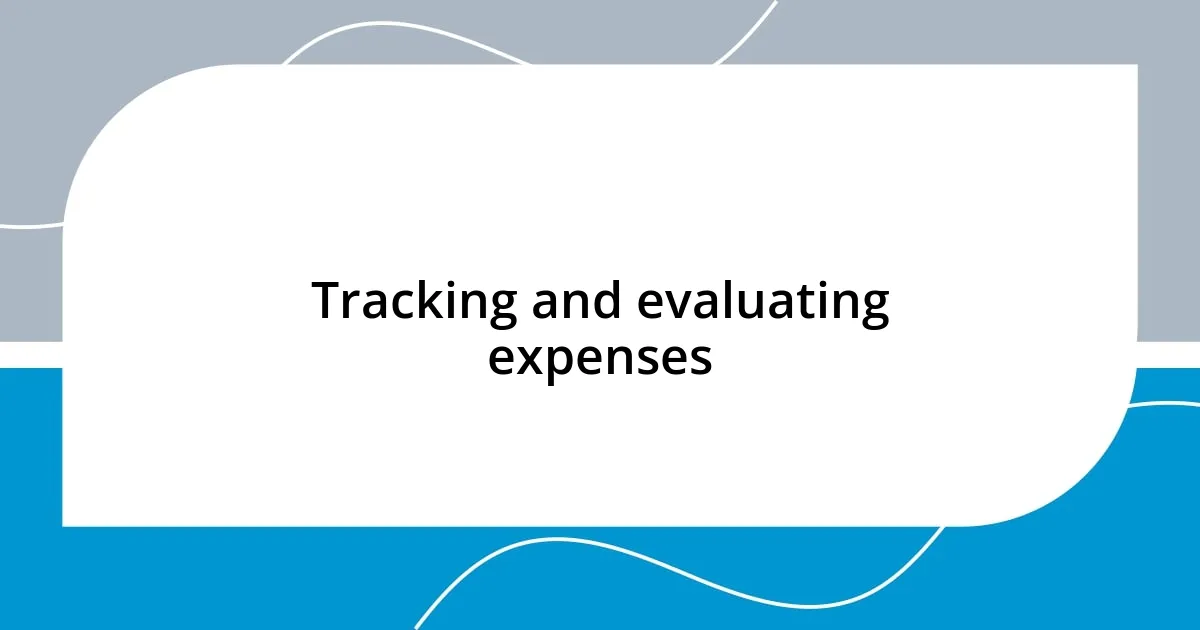
Tracking and evaluating expenses
Tracking and evaluating expenses is essential to ensure that your event remains within budget. I learned this firsthand when I organized a fundraising gala. I created a simple spreadsheet that listed every expense, from venue rental to floral arrangements. It was eye-opening to see where my money was going, and I was able to identify areas where I could cut back without sacrificing quality. Have you ever realized that small costs can add up quickly?
After the event, I meticulously reviewed the actual expenses against my projections. This process not only helped me understand where I overspent but also revealed opportunities for future savings. For instance, during that gala, I noticed our catering bill was significantly higher than expected. Reflecting on it later, I approached local culinary schools for my next event to provide student catering at a fraction of the cost. It’s all about analyzing the data you gather and making informed decisions for future planning.
Furthermore, I began incorporating a habit of tracking not just the expenses but also the value received from each item. I could see which elements of my events truly impacted guest satisfaction and which were just unnecessary frills. For example, when I assessed the entertainment cost, I realized that hiring a local band brought a vibrant atmosphere while remaining budget-friendly. How often do we invest in things without fully evaluating their impact? By being attentive to these details, I transformed my budgeting strategy into a valuable learning experience that refined my future events.











